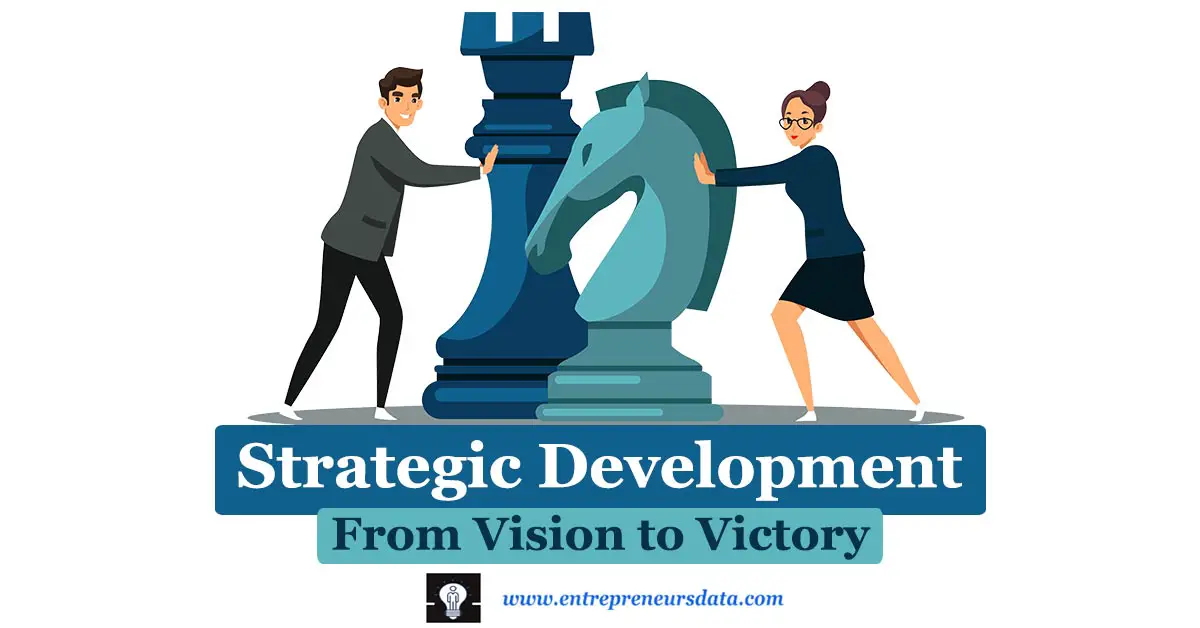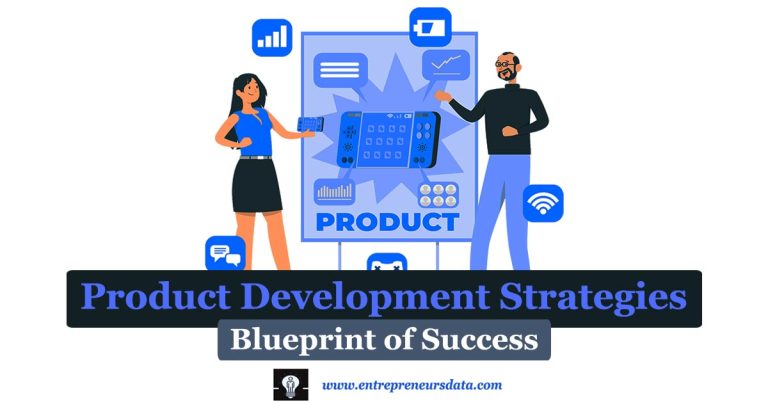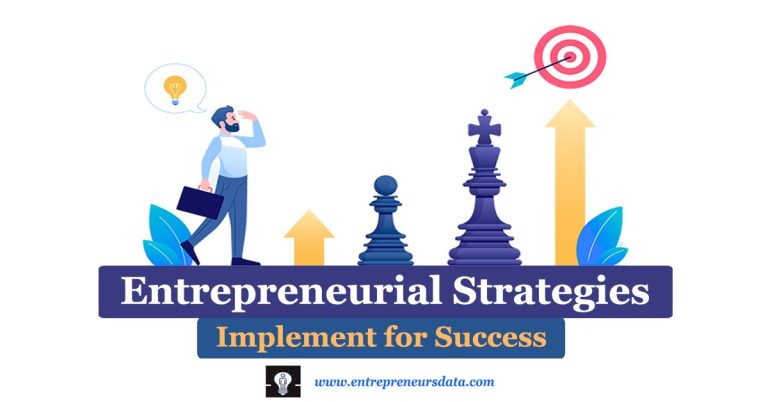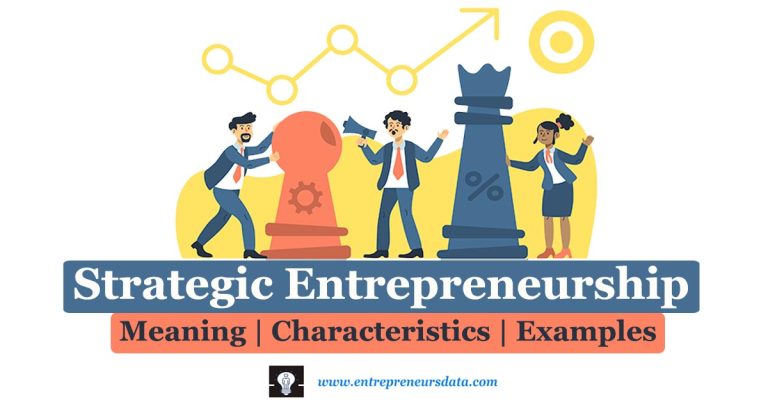Strategic Development: From Vision to Victory – Embarking on the entrepreneurial journey is akin to setting sail into the vast unknown, and in this ever-evolving landscape, strategic development becomes the entrepreneurial compass. What exactly is strategic development? It’s not just a term. It’s the heartbeat of entrepreneurial strategy.
In this article from “Strategic Development: From Vision to Victory,” we’ll delve into the very essence of this concept, unravelling its definition, understanding its real-world implications through examples, and discovering when new strategies become imperative. Let’s discuss, where we decode the art of strategic development and unveil the roadmap from envisioning success to achieving it.
What is Strategic Development?
Strategic development is a crucial aspect of an organization’s journey towards success. It involves defining an organization’s mission and vision, aligning resources with long-term goals, and creating a triumph plan.
It is a multifaceted approach that involves visionary foundations, alignment for success, planning for triumph, opportunity pursuit, adaptability in turbulent waters, positioning for triumph, decision-making, resource utilization, competitive advantage crafting, and leadership through uncertainty. Strategic development is akin to an entrepreneurial captain steering the ship confidently through uncharted waters.
Read – Strategic Entrepreneurship
Definition of Strategic Development
Defining the Path
Strategic development is about more than just setting goals; it’s about sculpting the very essence of an organization. According to Grant (2016), it involves crystallizing the mission and vision, providing a clear direction that becomes the heartbeat of the business.
Seizing Opportunities
Picture this: strategic development is the entrepreneurial eagle-eye, always on the lookout for opportunities that can skyrocket your business. As noted by Barney and Hesterly (2018), it’s a process of identifying and chasing down those golden chances that align with your long-term dreams.
Adapting to the Winds of Change
Entrepreneurial ventures are like sailing ships; the winds of change are inevitable. Thompson and Strickland (2020) stress that strategic development is the captain at the helm, skillfully managing change and steering the ship through uncharted waters.
Read – Modern Entrepreneurship
Gaining the Edge
In the bustling marketplace, standing out is key. Porter (2017) reveals that strategic development is your toolkit for creating a sustainable competitive advantage. It’s about crafting a unique proposition that makes competitors take a step back.
Guiding Through Uncertainty
Change is often accompanied by uncertainty, and that’s where strategic development truly shines. Kotter (2018) emphasizes that it’s the compass that guides an organization through the fog of uncertainty, providing clarity when the path ahead seems hazy.
Putting It All Together
Imagine strategic development as a symphony, with each element playing in harmony. It’s not just about one thing; it’s about weaving these facets together—mission and vision, opportunity pursuit, change management, competitive advantage, and navigating uncertainty.
Read – Barriers to Entrepreneurship
Strategic Development Meaning Using Real-World Example
Picture this: Walmart, a colossal retail giant, where strategic development isn’t just a buzzword; it’s the silent architect shaping their triumphs. Let’s unravel the tale of strategic development in the world of Walmart.
- Defining Clear Goals and Vision: At the heart of Walmart’s strategic development is a crystal-clear vision – “be the world’s most customer-centric retailer, where customers can find and discover anything they might want to buy online or in-store.”
- The goals they set aren’t just targets; they are stepping stones towards realizing this customer-centric vision.
- Aligning Goals with Vision: Walmart’s goals aren’t scattered; they are carefully aligned with its grand vision.
- Developing Strategic Plans: Now, imagine Walmart’s strategic plans as the roadmap to its vision.
When Do We Need to Develop New Strategies
In the entrepreneurial world, the need for new strategies arises when the current ones hit a roadblock, much like recalibrating your GPS when you encounter unexpected detours. Here are key triggers for strategic development:
Market Evolution
- Scenario: A new player with an innovative product steps into the market.
- Signs: Existing strategies lose their edge; competition intensifies.
- Response: Developing fresh strategies to regain a competitive advantage.
Market evolution can significantly influence the way organizations develop new strategies, as they need to adapt to new market trends, customer needs, and competitive landscapes. Here’s how market evolution drives new strategies.
Market evolution presents opportunities for organizations to expand their reach and introduce innovative products or services. They must adapt to changing customer needs. Also, respond to competitive landscape shifts, leverage technological advancements, and address regulatory and environmental changes.
By closely monitoring market trends, organizations can capitalize on emerging opportunities, meet customer demands, strengthen their position, and create new offerings. They must also stay updated on emerging technologies and ensure compliance with societal expectations.
Customer Evolution
- Scenario: Changing customer needs and preferences.
- Signs: Declining satisfaction, and demand for sustainable products.
- Response: Crafting strategies aligned with evolving customer expectations.
Customer evolution plays a significant role in shaping new strategies for organizations. As customer preferences, behaviours, and expectations change, organizations must adapt their approaches to maintain a competitive edge and achieve their business goals. Here’s how customer evolution influences strategic development:
Organizations must continuously understand customer needs and expectations through market research, customer feedback analysis, and social media monitoring. They should shift from a one-size-fits-all approach to personalized offerings using data analytics and CRM systems. They should also develop omnichannel strategies for seamless customer experiences across all touchpoints, adopting customer-centric technologies and fostering a customer focus.
They should embrace digital transformation, such as user-friendly platforms and AI integration, to meet customer expectations. Open communication with customers is crucial for refining products, improving services, and tailoring marketing campaigns.
Read – Sustainopreneurship
Technological Advancements
- Scenario: Emergence of game-changing technologies.
- Signs: Existing tech becomes outdated; efficiency lags.
- Response: Developing strategies to leverage new technologies for operational excellence.
Technological advancements significantly impact how organizations develop new strategies, as they open up new opportunities for innovation, process improvements, and market expansion. By embracing and integrating technological advancements into their strategies, organizations can gain a competitive edge, enhance customer experiences, and achieve their business goals. Here are some of the ways technological advancements influence strategic development:
Technological advancements enhance innovation and product development by enabling personalized products and data-driven insights. They improve operational efficiency and productivity by streamlining processes and reducing costs. They expand market reach and customer engagement through online platforms and mobile applications.
Technological advancements have the power to upend industries and generate new business models. as ride-hailing applications and online shopping. By using sustainable materials, smart city technologies, and renewable energy, they also assist in managing societal and environmental concerns.
Internal Transitions
- Scenario: Significant changes within the organization (e.g., leadership changes).
- Signs: Misalignment with the new vision and priorities.
- Response: Creating strategies that mirror the new leadership’s vision and goals.
Internal transitions can significantly impact how organizations develop new strategies. These transitions, such as leadership changes, mergers and acquisitions, or restructuring initiatives, can create both opportunities and challenges for strategic innovation. By understanding the impact of internal transitions and proactively addressing them, organizations can leverage these changes to strengthen their strategic direction and achieve their business goals.
Internal transitions offer organizations a chance to reevaluate their strategic direction, introducing new ideas and capabilities. However, they also present challenges and risks, such as cultural adjustments and the integration of different business models.
Effective communication and collaboration are crucial during these transitions to ensure employees understand the changes and opportunities for growth. Organizations must adapt to changing internal dynamics and leverage employee expertise to ensure new strategies align with evolving internal dynamics. This process can help organizations stay on track with their strategic initiatives.
Read – Innovative Entrepreneur
Strategic Development Process
In the entrepreneurial arena, strategic development isn’t a one-off event. It’s an ongoing journey. It describes a dynamic process that shapes the destiny of organizations. Let’s dive into the intricacies of this process.
Defining Mission and Vision
Mission: The heartbeat of purpose, defining why the organization exists.
Vision: A vivid picture of the future, outlining what the organization aspires to achieve.
These serve as the compass, guiding decisions and setting the groundwork for goals.
Analyzing the Environment
Internal: Identifying strengths and weaknesses within the organization.
External: Recognizing opportunities and threats in the broader landscape.
This analysis unveils the competitive advantage and illuminates potential challenges.
Read – Low-Cost High Profit Franchises
Setting SMART Objectives
Specific, Measurable, Achievable, Relevant, Time-bound (SMART): The litmus test for goals.
These objectives become tangible milestones, aligned meticulously with the mission and vision.
Developing Action Plans:
Specific tasks, deadlines, and responsible parties take centre stage.
Action plans transform objectives into a roadmap, offering a clear path to the envisioned destination.
Implementing and Evaluating
Resources are allocated, and the strategy is set into motion.
Monitoring progress becomes paramount, involving the scrutiny of Key Performance Indicators (KPIs) and adjustments as necessary.
Read – Technology in Entrepreneurship
Stages Of the Strategic Development Process
Stage 1: Define the Strategic Direction
Establish mission, vision, and values.
Conduct a SWOT analysis.
Identify key strategic issues and challenges.
Stage 2: Formulate Strategic Plans
Develop SMART objectives aligned with the mission and vision.
Prioritize strategic initiatives based on importance and feasibility.
Craft detailed action plans for each initiative.
Stage 3: Implement and Execute Strategies
Allocate resources to implement action plans.
Assign responsibilities and timelines.
Communicate the strategy to stakeholders.
Monitor and evaluate progress.
Read – Best Degrees for Entrepreneurs
Stage 4: Continuous Evaluation and Adaptation
Regularly review and assess strategy effectiveness.
Make adjustments based on changing circumstances.
Foster a culture of innovation and continuous improvement.
The strategic development process is a fluid, non-linear expedition that demands adaptability. It’s an entrepreneurial dance with change, a rhythm of continuous evaluation and adaptation. In this dynamic landscape, flexibility is the key, and the willingness to adjust the sails is what propels organizations towards their desired outcomes.
Strategic Development Examples
Let’s delve into the dynamic realm of strategic development with concrete examples from industry giants.
Google’s Strategic Development
Mission Focus: Google’s mission to “organize the world’s information and make it universally accessible and useful” has driven strategic initiatives.
Product Expansion: Beyond the core search engine, Google has diversified with products like Gmail, YouTube, and Android.
Global Reach: Operating in over 200 countries, Google strategically expands its global footprint.
Apple’s Strategic Development
Mission Commitment: Apple’s mission is to “bring the best personal computing experience to customers.”
Integrated Approach: Designing and manufacturing products in-house gives Apple control over the user experience.
Brand Building: Apple’s strategic focus on innovation and quality has cultivated a strong and iconic brand reputation.
Unique Retail Experience: Apple’s retail stores, numbering over 500 worldwide, contribute to a distinctive customer experience.
Read – Global Entrepreneurs
Starbucks’ Strategic Development
The mission of Inspiration: Starbucks hopes to uplift and nourish the human spirit, one neighbourhood, one cup, and one individual at a time.
Customer-Centric Approach: Starbucks creates a unique experience by offering high-quality coffee in inviting surroundings.
Global Expansion: Operating in over 80 countries, Starbucks strategically expands its global reach.
Innovative Offerings: Starbucks introduces new products and services like bottled Frappuccinos and mobile ordering to cater to diverse customer preferences.
In these examples, strategic development isn’t a theoretical concept but a vibrant and dynamic force shaping the trajectory of industry leaders. It’s about aligning vision with action, innovating to meet evolving needs, and strategically expanding to make a mark on a global scale. These entrepreneurial powerhouses showcase that strategic development isn’t just a plan—it’s a living, breathing strategy that propels success.
Conclusion
As we bring our journey through “Strategic Development: From Vision to Victory” to a close, it becomes evident that this entrepreneurial compass is not merely a theoretical concept but a dynamic force propelling ventures towards success. Strategic development, the heartbeat of entrepreneurial strategy, transforms vision into tangible victories. From understanding its essence to decoding the process, exploring real-world examples, and recognizing the crucial moments necessitating new strategies, entrepreneurs are equipped with the tools to navigate the ever-changing business landscape.
The stages of strategic development unveil a roadmap, emphasizing adaptability and a continuous quest for improvement. The examples of industry leaders like Google, Apple, and Starbucks serve as beacons, showcasing the power of strategic development in action. As you set sail with newfound insights, may your entrepreneurial voyage be guided by strategic development, steering you towards the victories you envision.
FAQs on Strategic Development
What do you mean by strategic development?
Strategic development is the blueprint for long-term success. It’s the thoughtful process of setting goals. Also, understanding the resources required to reach those goals, and drafting a detailed plan on how to use those resources effectively. Think of it as the entrepreneurial roadmap, outlining the journey from envisioning success to achieving it.
What are the 4 aspects of strategic development?
Strategic development revolves around four key aspects, each playing a crucial role:
- Vision: The compass pointing towards the organization’s overarching direction.
- Mission: The specific purpose, defining the organization’s reason for existence.
- Goals: Tangible objectives, the stepping stones towards the envisioned future.
- Strategies: The actionable plans, the roadmap detailing how goals will be achieved. These four aspects together form the foundation of strategic development.
What is the role of strategic development?
The role of strategic development is akin to a wise navigator guiding a ship through tumultuous waters. Its primary functions include helping organizations focus on critical initiatives, facilitating informed resource allocation decisions, preventing costly mistakes, and enabling adaptability to changing market conditions. Essentially, strategic development is the entrepreneurial compass steering organizations towards their long-term goals.
What are the steps in strategic development?
Strategic development unfolds through a systematic process, embracing the following steps.
- Define Mission and Vision: Establish the organization’s purpose and overarching direction.
- SWOT Analysis: Identify Strengths, Weaknesses, Opportunities, and Threats.
- Set Strategic Goals: Outline specific, measurable objectives aligned with the mission and vision.
- Develop Action Plans: Craft detailed roadmaps for each strategic initiative.
- Implement the Strategy: Put the plans into action, allocating resources judiciously.
- Evaluate Results: Regularly assess the strategy’s effectiveness, making adjustments as needed. It’s a dynamic process that propels organizations forward.
What are the pillars of strategic development?
The pillars of strategic development are the foundational principles essential for organizational success:
- Customer Focus: Understanding and meeting customer needs are paramount for sustained success.
- Innovation: Continuous development of new products, services, and processes is the key to staying ahead.
- Efficiency: Operating cost-effectively is crucial for profitability and sustainability.
- Talent management: The victory of an organization depends on attracting, nurturing, and holding excellent talent.
- Adaptability: The key to long-term survival is the ability to modify and adjust to changing market conditions.





